Report: Analyzing Gender Inequality in the Workplace and Solutions
VerifiedAdded on 2020/05/28
|13
|2820
|226
Report
AI Summary
This report provides an in-depth analysis of gender inequality in the workplace, focusing on the Australian context. It begins with an executive summary highlighting the scope, which includes evaluating gender inequality, examining relevant theories, and analyzing contributing factors. The report explores the prevalence of gender inequality in the labor market, discussing gender socialization and its impact on traditional gender roles. It examines job-based divisions and the pay gap, emphasizing the need for flexible working conditions to support women. The report then delves into various theories of gender inequality, including inequality and modernization theories. It analyzes the current state of gender inequality in Australia, noting the underrepresentation of women in leadership roles and the efforts to improve gender balance. Finally, the report offers recommendations, such as implementing targets for female representation on boards and addressing discrimination, and concludes with a call for coordinated efforts to eradicate workplace gender inequality.
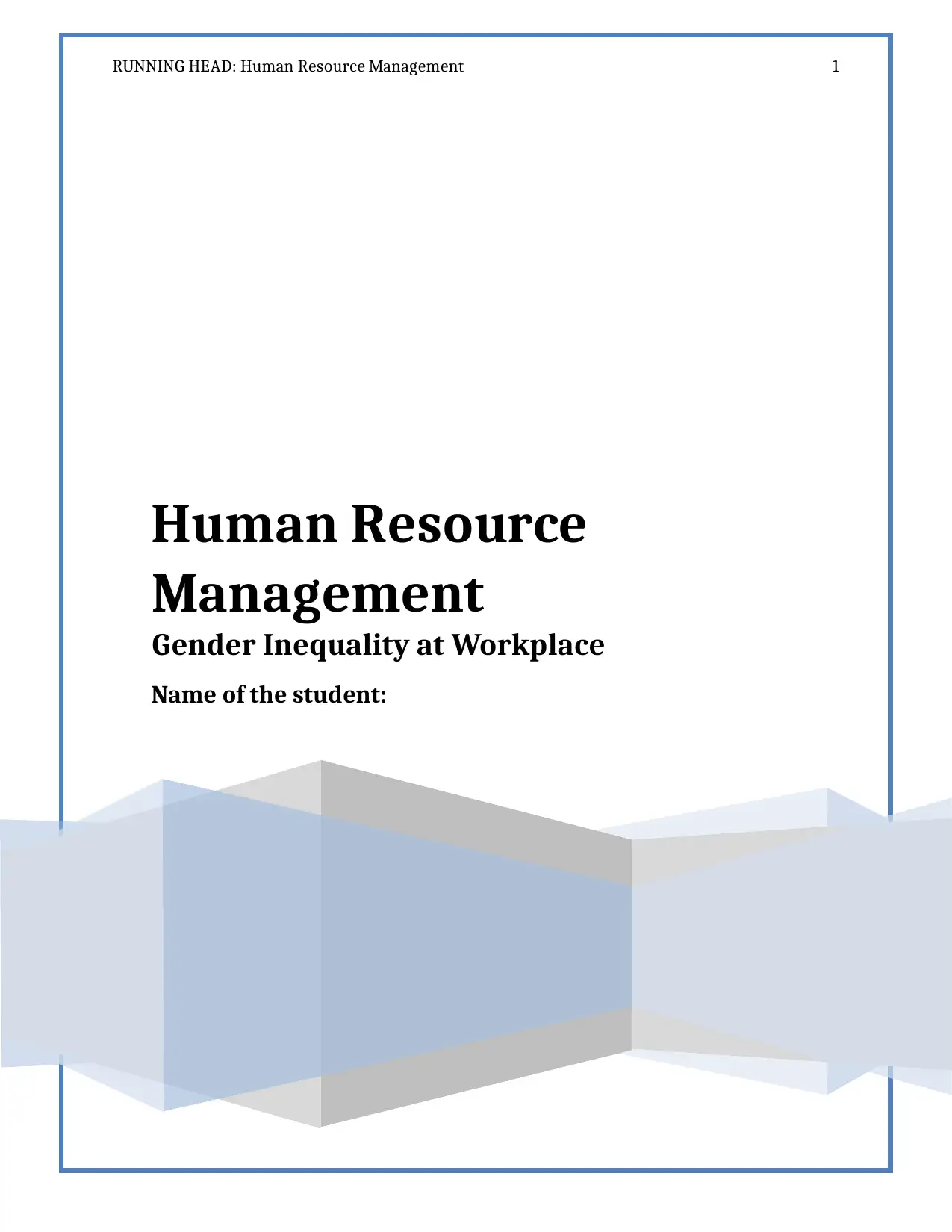
RUNNING HEAD: Human Resource Management 1
Human Resource
Management
Gender Inequality at Workplace
Name of the student:
Human Resource
Management
Gender Inequality at Workplace
Name of the student:
Paraphrase This Document
Need a fresh take? Get an instant paraphrase of this document with our AI Paraphraser
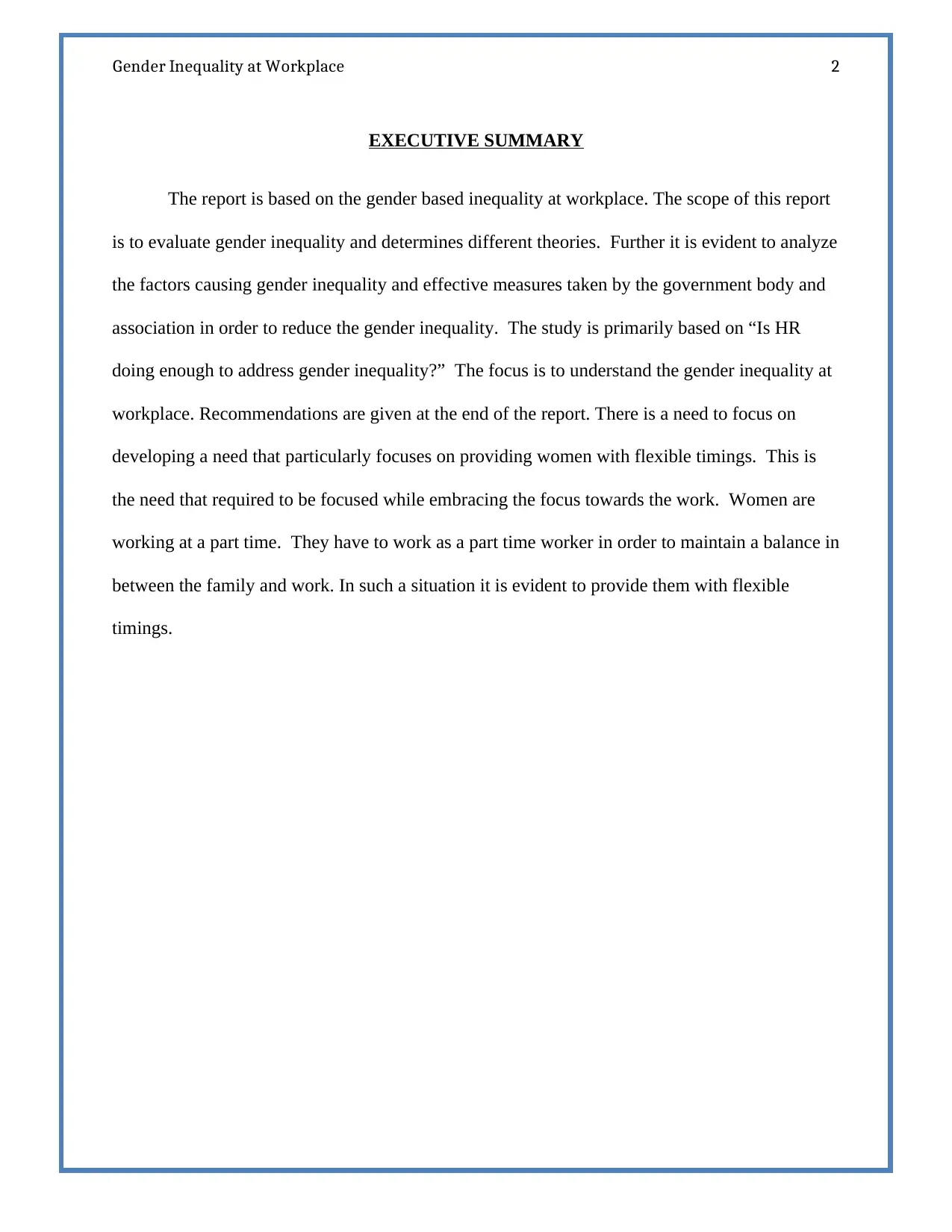
Gender Inequality at Workplace 2
EXECUTIVE SUMMARY
The report is based on the gender based inequality at workplace. The scope of this report
is to evaluate gender inequality and determines different theories. Further it is evident to analyze
the factors causing gender inequality and effective measures taken by the government body and
association in order to reduce the gender inequality. The study is primarily based on “Is HR
doing enough to address gender inequality?” The focus is to understand the gender inequality at
workplace. Recommendations are given at the end of the report. There is a need to focus on
developing a need that particularly focuses on providing women with flexible timings. This is
the need that required to be focused while embracing the focus towards the work. Women are
working at a part time. They have to work as a part time worker in order to maintain a balance in
between the family and work. In such a situation it is evident to provide them with flexible
timings.
EXECUTIVE SUMMARY
The report is based on the gender based inequality at workplace. The scope of this report
is to evaluate gender inequality and determines different theories. Further it is evident to analyze
the factors causing gender inequality and effective measures taken by the government body and
association in order to reduce the gender inequality. The study is primarily based on “Is HR
doing enough to address gender inequality?” The focus is to understand the gender inequality at
workplace. Recommendations are given at the end of the report. There is a need to focus on
developing a need that particularly focuses on providing women with flexible timings. This is
the need that required to be focused while embracing the focus towards the work. Women are
working at a part time. They have to work as a part time worker in order to maintain a balance in
between the family and work. In such a situation it is evident to provide them with flexible
timings.
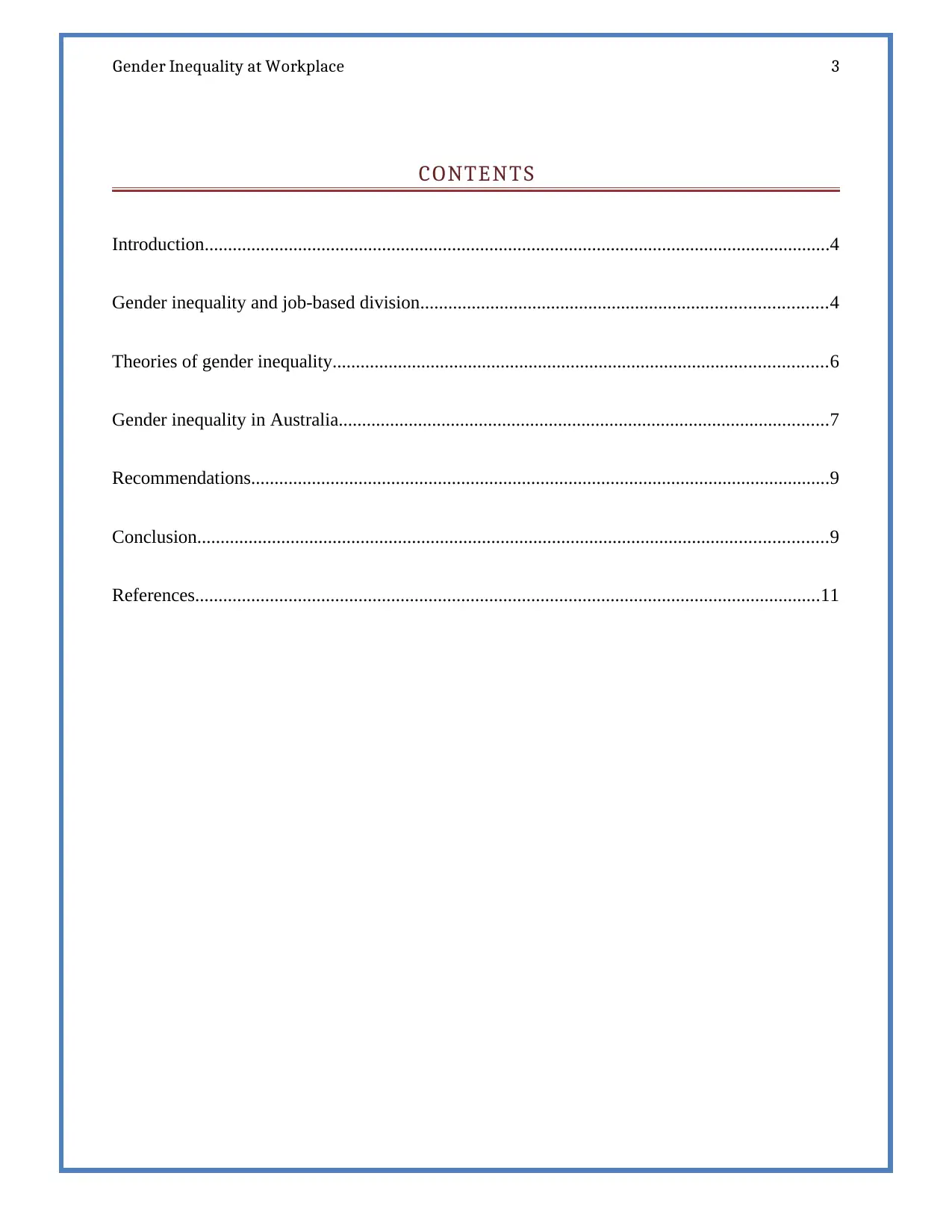
Gender Inequality at Workplace 3
CONTENTS
Introduction......................................................................................................................................4
Gender inequality and job-based division.......................................................................................4
Theories of gender inequality..........................................................................................................6
Gender inequality in Australia.........................................................................................................7
Recommendations............................................................................................................................9
Conclusion.......................................................................................................................................9
References......................................................................................................................................11
CONTENTS
Introduction......................................................................................................................................4
Gender inequality and job-based division.......................................................................................4
Theories of gender inequality..........................................................................................................6
Gender inequality in Australia.........................................................................................................7
Recommendations............................................................................................................................9
Conclusion.......................................................................................................................................9
References......................................................................................................................................11
⊘ This is a preview!⊘
Do you want full access?
Subscribe today to unlock all pages.

Trusted by 1+ million students worldwide
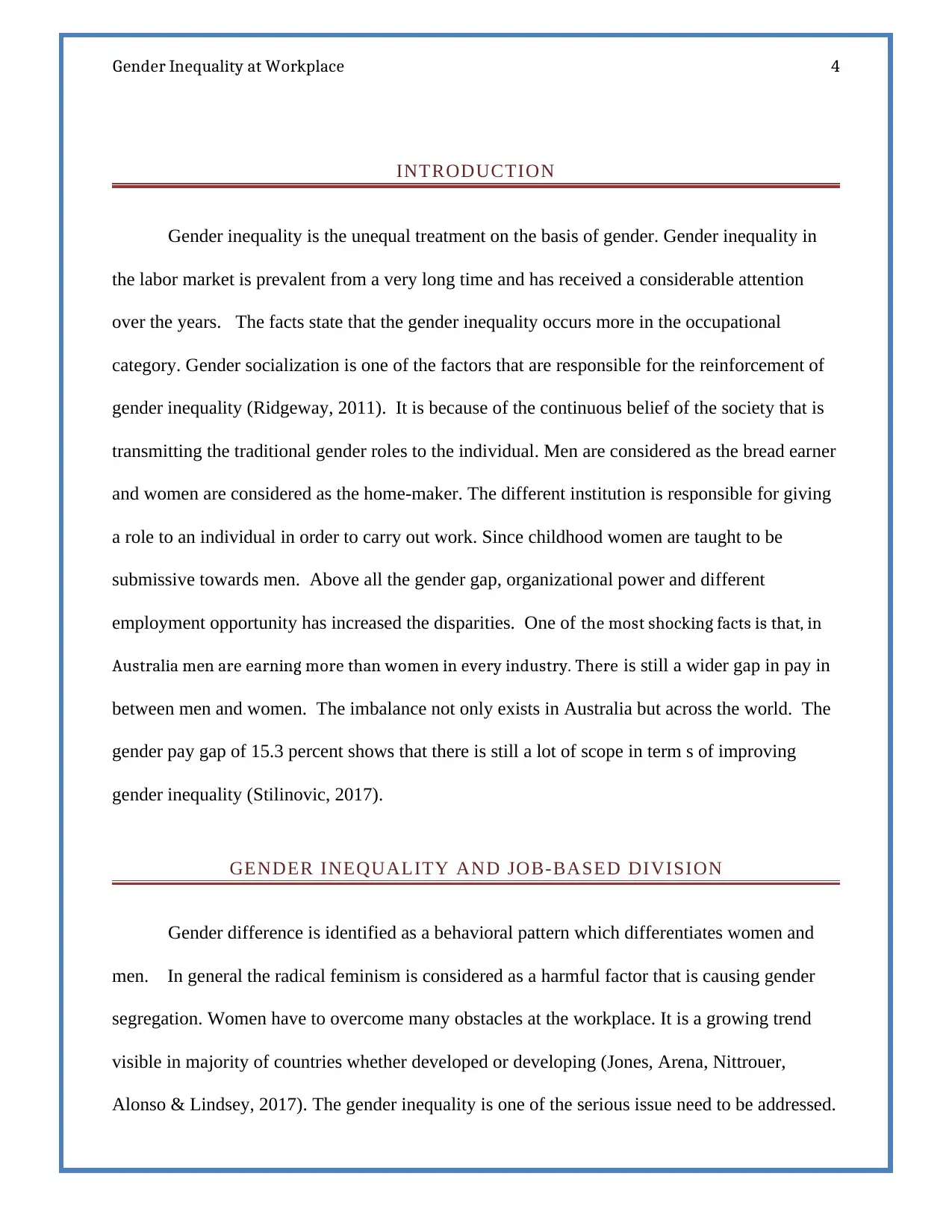
Gender Inequality at Workplace 4
INTRODUCTION
Gender inequality is the unequal treatment on the basis of gender. Gender inequality in
the labor market is prevalent from a very long time and has received a considerable attention
over the years. The facts state that the gender inequality occurs more in the occupational
category. Gender socialization is one of the factors that are responsible for the reinforcement of
gender inequality (Ridgeway, 2011). It is because of the continuous belief of the society that is
transmitting the traditional gender roles to the individual. Men are considered as the bread earner
and women are considered as the home-maker. The different institution is responsible for giving
a role to an individual in order to carry out work. Since childhood women are taught to be
submissive towards men. Above all the gender gap, organizational power and different
employment opportunity has increased the disparities. One of the most shocking facts is that, in
Australia men are earning more than women in every industry. There is still a wider gap in pay in
between men and women. The imbalance not only exists in Australia but across the world. The
gender pay gap of 15.3 percent shows that there is still a lot of scope in term s of improving
gender inequality (Stilinovic, 2017).
GENDER INEQUALITY AND JOB-BASED DIVISION
Gender difference is identified as a behavioral pattern which differentiates women and
men. In general the radical feminism is considered as a harmful factor that is causing gender
segregation. Women have to overcome many obstacles at the workplace. It is a growing trend
visible in majority of countries whether developed or developing (Jones, Arena, Nittrouer,
Alonso & Lindsey, 2017). The gender inequality is one of the serious issue need to be addressed.
INTRODUCTION
Gender inequality is the unequal treatment on the basis of gender. Gender inequality in
the labor market is prevalent from a very long time and has received a considerable attention
over the years. The facts state that the gender inequality occurs more in the occupational
category. Gender socialization is one of the factors that are responsible for the reinforcement of
gender inequality (Ridgeway, 2011). It is because of the continuous belief of the society that is
transmitting the traditional gender roles to the individual. Men are considered as the bread earner
and women are considered as the home-maker. The different institution is responsible for giving
a role to an individual in order to carry out work. Since childhood women are taught to be
submissive towards men. Above all the gender gap, organizational power and different
employment opportunity has increased the disparities. One of the most shocking facts is that, in
Australia men are earning more than women in every industry. There is still a wider gap in pay in
between men and women. The imbalance not only exists in Australia but across the world. The
gender pay gap of 15.3 percent shows that there is still a lot of scope in term s of improving
gender inequality (Stilinovic, 2017).
GENDER INEQUALITY AND JOB-BASED DIVISION
Gender difference is identified as a behavioral pattern which differentiates women and
men. In general the radical feminism is considered as a harmful factor that is causing gender
segregation. Women have to overcome many obstacles at the workplace. It is a growing trend
visible in majority of countries whether developed or developing (Jones, Arena, Nittrouer,
Alonso & Lindsey, 2017). The gender inequality is one of the serious issue need to be addressed.
Paraphrase This Document
Need a fresh take? Get an instant paraphrase of this document with our AI Paraphraser
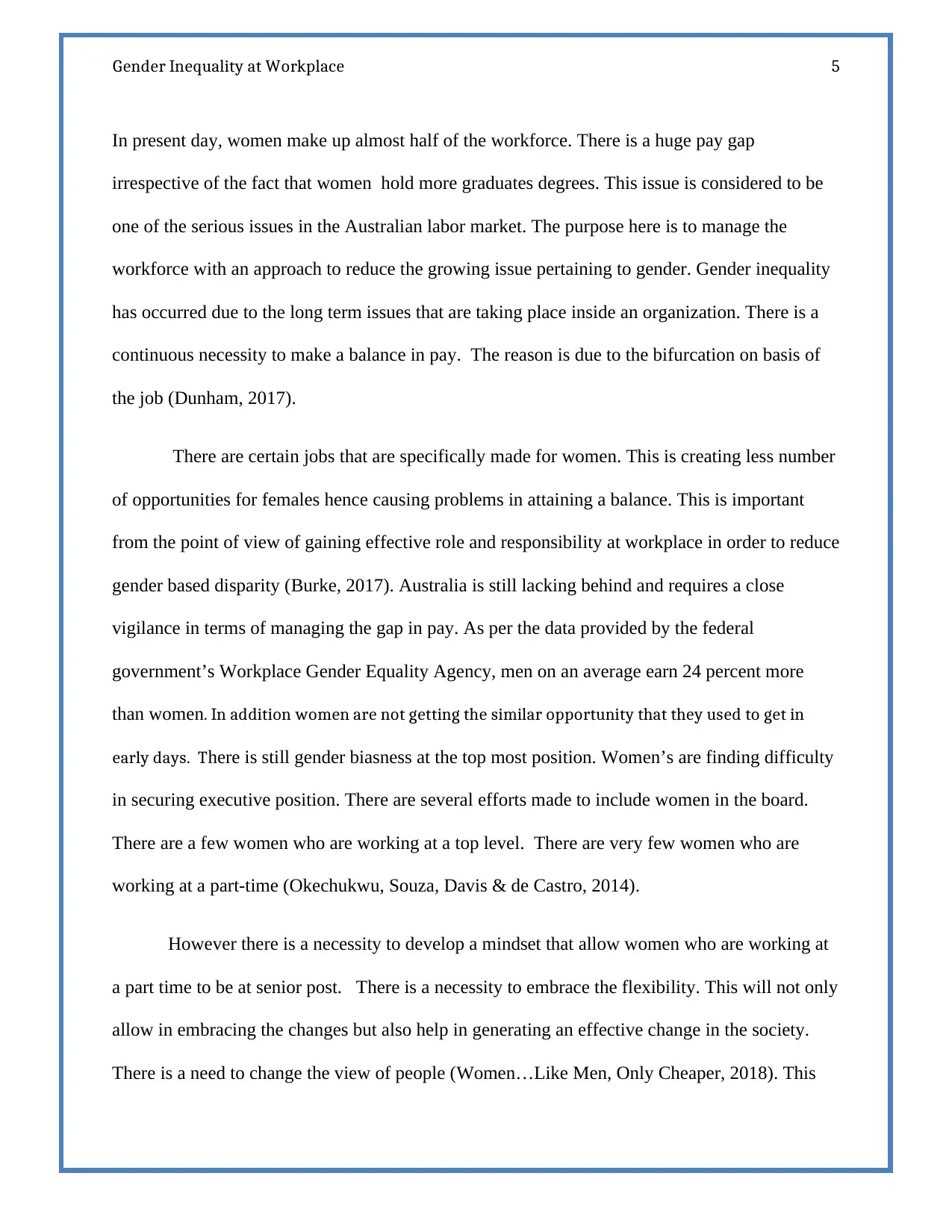
Gender Inequality at Workplace 5
In present day, women make up almost half of the workforce. There is a huge pay gap
irrespective of the fact that women hold more graduates degrees. This issue is considered to be
one of the serious issues in the Australian labor market. The purpose here is to manage the
workforce with an approach to reduce the growing issue pertaining to gender. Gender inequality
has occurred due to the long term issues that are taking place inside an organization. There is a
continuous necessity to make a balance in pay. The reason is due to the bifurcation on basis of
the job (Dunham, 2017).
There are certain jobs that are specifically made for women. This is creating less number
of opportunities for females hence causing problems in attaining a balance. This is important
from the point of view of gaining effective role and responsibility at workplace in order to reduce
gender based disparity (Burke, 2017). Australia is still lacking behind and requires a close
vigilance in terms of managing the gap in pay. As per the data provided by the federal
government’s Workplace Gender Equality Agency, men on an average earn 24 percent more
than women. In addition women are not getting the similar opportunity that they used to get in
early days. There is still gender biasness at the top most position. Women’s are finding difficulty
in securing executive position. There are several efforts made to include women in the board.
There are a few women who are working at a top level. There are very few women who are
working at a part-time (Okechukwu, Souza, Davis & de Castro, 2014).
However there is a necessity to develop a mindset that allow women who are working at
a part time to be at senior post. There is a necessity to embrace the flexibility. This will not only
allow in embracing the changes but also help in generating an effective change in the society.
There is a need to change the view of people (Women…Like Men, Only Cheaper, 2018). This
In present day, women make up almost half of the workforce. There is a huge pay gap
irrespective of the fact that women hold more graduates degrees. This issue is considered to be
one of the serious issues in the Australian labor market. The purpose here is to manage the
workforce with an approach to reduce the growing issue pertaining to gender. Gender inequality
has occurred due to the long term issues that are taking place inside an organization. There is a
continuous necessity to make a balance in pay. The reason is due to the bifurcation on basis of
the job (Dunham, 2017).
There are certain jobs that are specifically made for women. This is creating less number
of opportunities for females hence causing problems in attaining a balance. This is important
from the point of view of gaining effective role and responsibility at workplace in order to reduce
gender based disparity (Burke, 2017). Australia is still lacking behind and requires a close
vigilance in terms of managing the gap in pay. As per the data provided by the federal
government’s Workplace Gender Equality Agency, men on an average earn 24 percent more
than women. In addition women are not getting the similar opportunity that they used to get in
early days. There is still gender biasness at the top most position. Women’s are finding difficulty
in securing executive position. There are several efforts made to include women in the board.
There are a few women who are working at a top level. There are very few women who are
working at a part-time (Okechukwu, Souza, Davis & de Castro, 2014).
However there is a necessity to develop a mindset that allow women who are working at
a part time to be at senior post. There is a necessity to embrace the flexibility. This will not only
allow in embracing the changes but also help in generating an effective change in the society.
There is a need to change the view of people (Women…Like Men, Only Cheaper, 2018). This
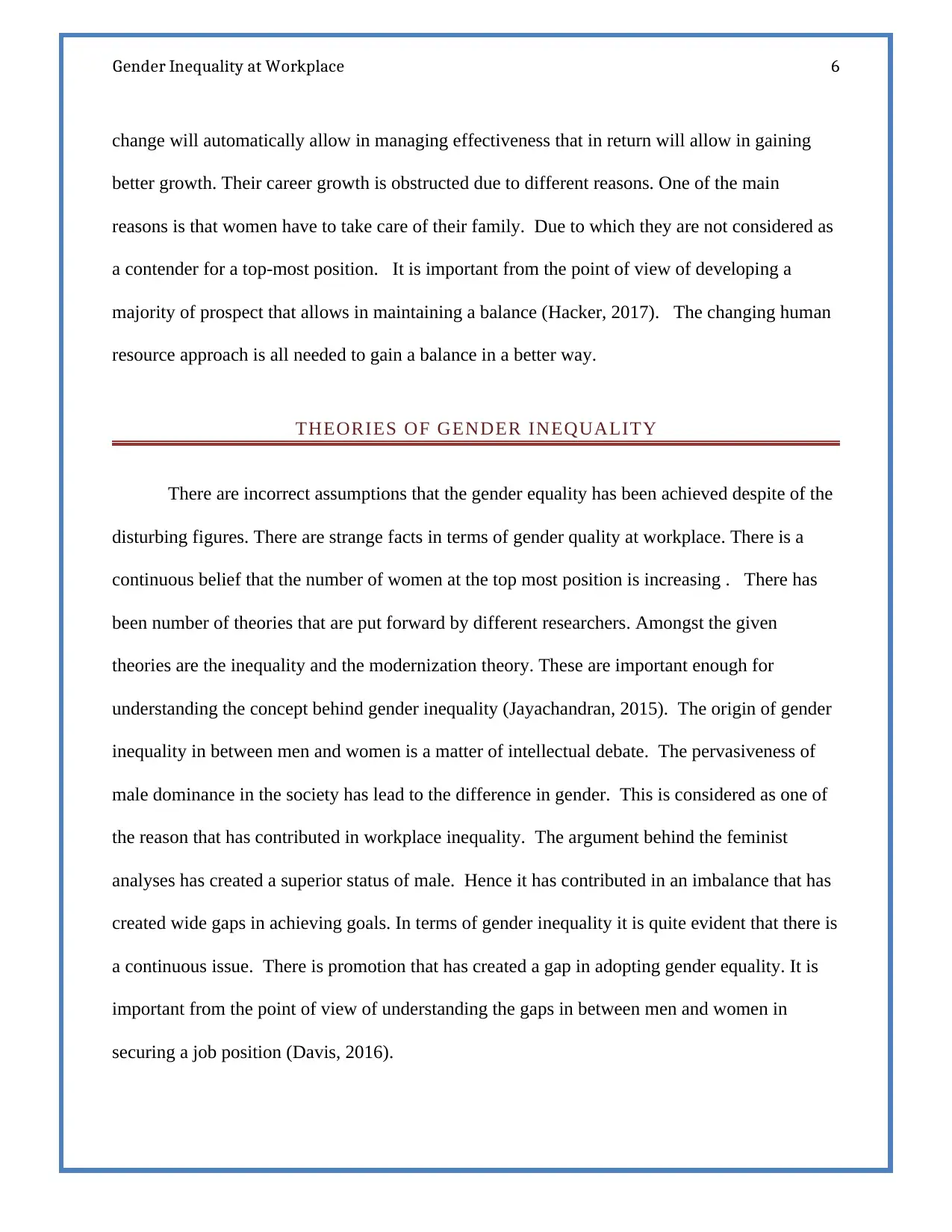
Gender Inequality at Workplace 6
change will automatically allow in managing effectiveness that in return will allow in gaining
better growth. Their career growth is obstructed due to different reasons. One of the main
reasons is that women have to take care of their family. Due to which they are not considered as
a contender for a top-most position. It is important from the point of view of developing a
majority of prospect that allows in maintaining a balance (Hacker, 2017). The changing human
resource approach is all needed to gain a balance in a better way.
THEORIES OF GENDER INEQUALITY
There are incorrect assumptions that the gender equality has been achieved despite of the
disturbing figures. There are strange facts in terms of gender quality at workplace. There is a
continuous belief that the number of women at the top most position is increasing . There has
been number of theories that are put forward by different researchers. Amongst the given
theories are the inequality and the modernization theory. These are important enough for
understanding the concept behind gender inequality (Jayachandran, 2015). The origin of gender
inequality in between men and women is a matter of intellectual debate. The pervasiveness of
male dominance in the society has lead to the difference in gender. This is considered as one of
the reason that has contributed in workplace inequality. The argument behind the feminist
analyses has created a superior status of male. Hence it has contributed in an imbalance that has
created wide gaps in achieving goals. In terms of gender inequality it is quite evident that there is
a continuous issue. There is promotion that has created a gap in adopting gender equality. It is
important from the point of view of understanding the gaps in between men and women in
securing a job position (Davis, 2016).
change will automatically allow in managing effectiveness that in return will allow in gaining
better growth. Their career growth is obstructed due to different reasons. One of the main
reasons is that women have to take care of their family. Due to which they are not considered as
a contender for a top-most position. It is important from the point of view of developing a
majority of prospect that allows in maintaining a balance (Hacker, 2017). The changing human
resource approach is all needed to gain a balance in a better way.
THEORIES OF GENDER INEQUALITY
There are incorrect assumptions that the gender equality has been achieved despite of the
disturbing figures. There are strange facts in terms of gender quality at workplace. There is a
continuous belief that the number of women at the top most position is increasing . There has
been number of theories that are put forward by different researchers. Amongst the given
theories are the inequality and the modernization theory. These are important enough for
understanding the concept behind gender inequality (Jayachandran, 2015). The origin of gender
inequality in between men and women is a matter of intellectual debate. The pervasiveness of
male dominance in the society has lead to the difference in gender. This is considered as one of
the reason that has contributed in workplace inequality. The argument behind the feminist
analyses has created a superior status of male. Hence it has contributed in an imbalance that has
created wide gaps in achieving goals. In terms of gender inequality it is quite evident that there is
a continuous issue. There is promotion that has created a gap in adopting gender equality. It is
important from the point of view of understanding the gaps in between men and women in
securing a job position (Davis, 2016).
⊘ This is a preview!⊘
Do you want full access?
Subscribe today to unlock all pages.

Trusted by 1+ million students worldwide
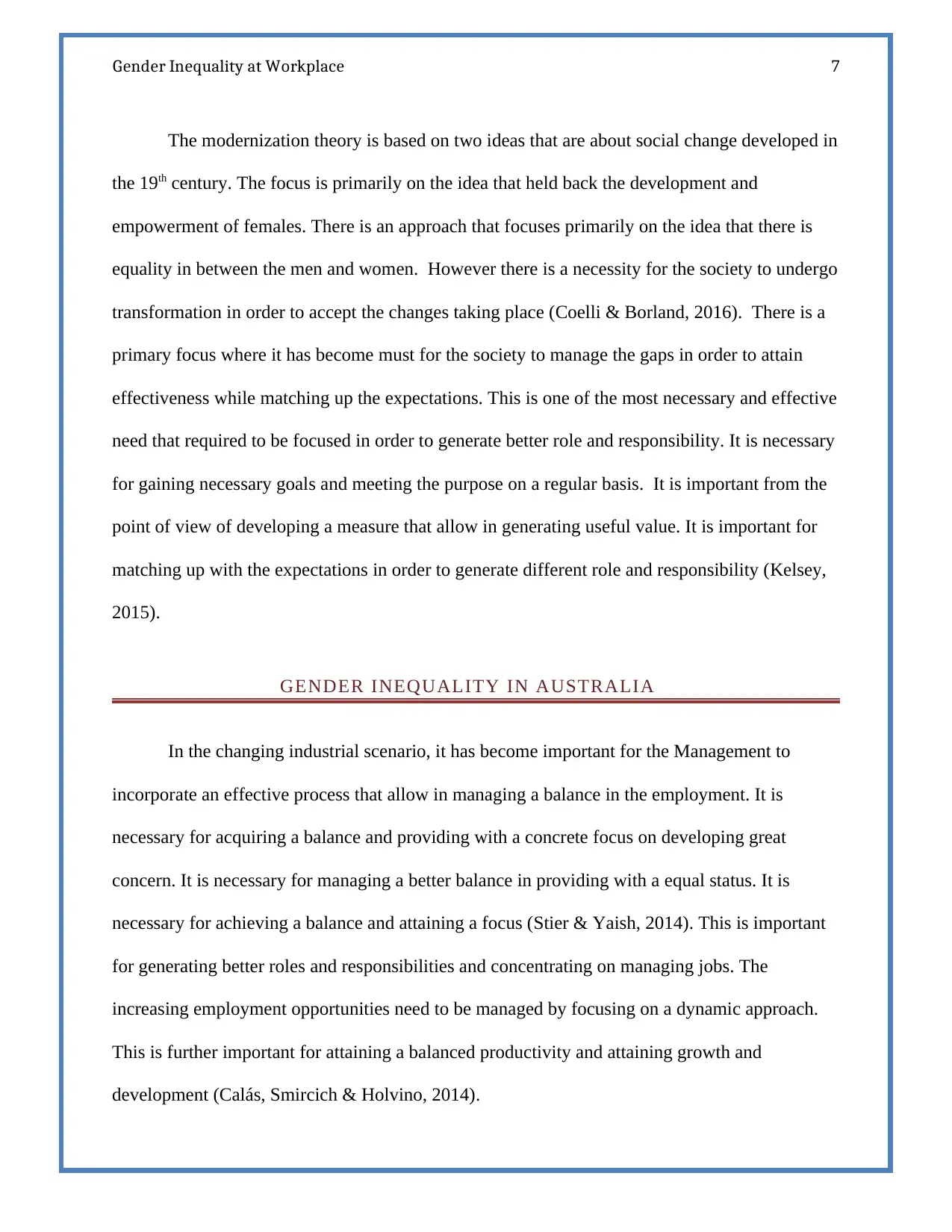
Gender Inequality at Workplace 7
The modernization theory is based on two ideas that are about social change developed in
the 19th century. The focus is primarily on the idea that held back the development and
empowerment of females. There is an approach that focuses primarily on the idea that there is
equality in between the men and women. However there is a necessity for the society to undergo
transformation in order to accept the changes taking place (Coelli & Borland, 2016). There is a
primary focus where it has become must for the society to manage the gaps in order to attain
effectiveness while matching up the expectations. This is one of the most necessary and effective
need that required to be focused in order to generate better role and responsibility. It is necessary
for gaining necessary goals and meeting the purpose on a regular basis. It is important from the
point of view of developing a measure that allow in generating useful value. It is important for
matching up with the expectations in order to generate different role and responsibility (Kelsey,
2015).
GENDER INEQUALITY IN AUSTRALIA
In the changing industrial scenario, it has become important for the Management to
incorporate an effective process that allow in managing a balance in the employment. It is
necessary for acquiring a balance and providing with a concrete focus on developing great
concern. It is necessary for managing a better balance in providing with a equal status. It is
necessary for achieving a balance and attaining a focus (Stier & Yaish, 2014). This is important
for generating better roles and responsibilities and concentrating on managing jobs. The
increasing employment opportunities need to be managed by focusing on a dynamic approach.
This is further important for attaining a balanced productivity and attaining growth and
development (Calás, Smircich & Holvino, 2014).
The modernization theory is based on two ideas that are about social change developed in
the 19th century. The focus is primarily on the idea that held back the development and
empowerment of females. There is an approach that focuses primarily on the idea that there is
equality in between the men and women. However there is a necessity for the society to undergo
transformation in order to accept the changes taking place (Coelli & Borland, 2016). There is a
primary focus where it has become must for the society to manage the gaps in order to attain
effectiveness while matching up the expectations. This is one of the most necessary and effective
need that required to be focused in order to generate better role and responsibility. It is necessary
for gaining necessary goals and meeting the purpose on a regular basis. It is important from the
point of view of developing a measure that allow in generating useful value. It is important for
matching up with the expectations in order to generate different role and responsibility (Kelsey,
2015).
GENDER INEQUALITY IN AUSTRALIA
In the changing industrial scenario, it has become important for the Management to
incorporate an effective process that allow in managing a balance in the employment. It is
necessary for acquiring a balance and providing with a concrete focus on developing great
concern. It is necessary for managing a better balance in providing with a equal status. It is
necessary for achieving a balance and attaining a focus (Stier & Yaish, 2014). This is important
for generating better roles and responsibilities and concentrating on managing jobs. The
increasing employment opportunities need to be managed by focusing on a dynamic approach.
This is further important for attaining a balanced productivity and attaining growth and
development (Calás, Smircich & Holvino, 2014).
Paraphrase This Document
Need a fresh take? Get an instant paraphrase of this document with our AI Paraphraser
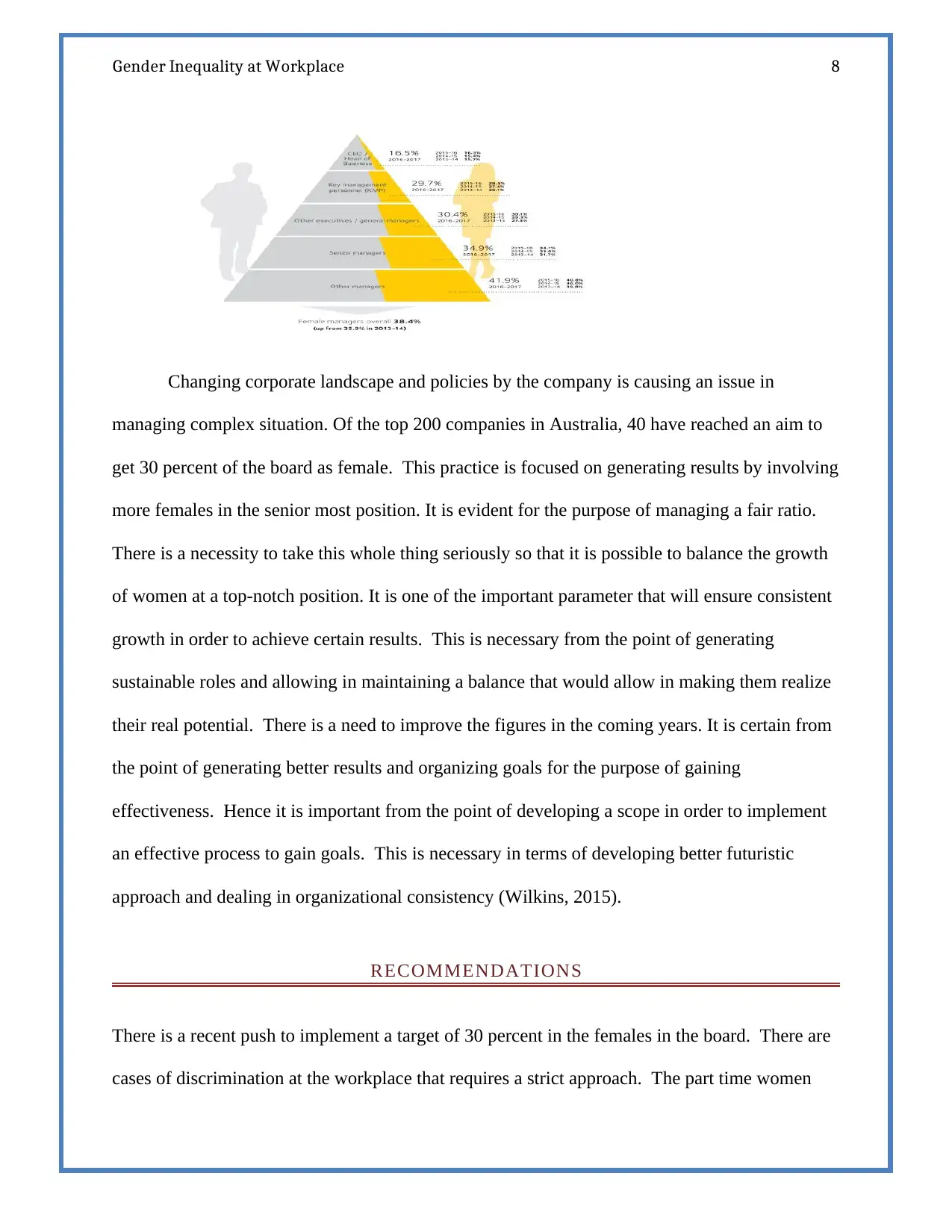
Gender Inequality at Workplace 8
Changing corporate landscape and policies by the company is causing an issue in
managing complex situation. Of the top 200 companies in Australia, 40 have reached an aim to
get 30 percent of the board as female. This practice is focused on generating results by involving
more females in the senior most position. It is evident for the purpose of managing a fair ratio.
There is a necessity to take this whole thing seriously so that it is possible to balance the growth
of women at a top-notch position. It is one of the important parameter that will ensure consistent
growth in order to achieve certain results. This is necessary from the point of generating
sustainable roles and allowing in maintaining a balance that would allow in making them realize
their real potential. There is a need to improve the figures in the coming years. It is certain from
the point of generating better results and organizing goals for the purpose of gaining
effectiveness. Hence it is important from the point of developing a scope in order to implement
an effective process to gain goals. This is necessary in terms of developing better futuristic
approach and dealing in organizational consistency (Wilkins, 2015).
RECOMMENDATIONS
There is a recent push to implement a target of 30 percent in the females in the board. There are
cases of discrimination at the workplace that requires a strict approach. The part time women
Changing corporate landscape and policies by the company is causing an issue in
managing complex situation. Of the top 200 companies in Australia, 40 have reached an aim to
get 30 percent of the board as female. This practice is focused on generating results by involving
more females in the senior most position. It is evident for the purpose of managing a fair ratio.
There is a necessity to take this whole thing seriously so that it is possible to balance the growth
of women at a top-notch position. It is one of the important parameter that will ensure consistent
growth in order to achieve certain results. This is necessary from the point of generating
sustainable roles and allowing in maintaining a balance that would allow in making them realize
their real potential. There is a need to improve the figures in the coming years. It is certain from
the point of generating better results and organizing goals for the purpose of gaining
effectiveness. Hence it is important from the point of developing a scope in order to implement
an effective process to gain goals. This is necessary in terms of developing better futuristic
approach and dealing in organizational consistency (Wilkins, 2015).
RECOMMENDATIONS
There is a recent push to implement a target of 30 percent in the females in the board. There are
cases of discrimination at the workplace that requires a strict approach. The part time women
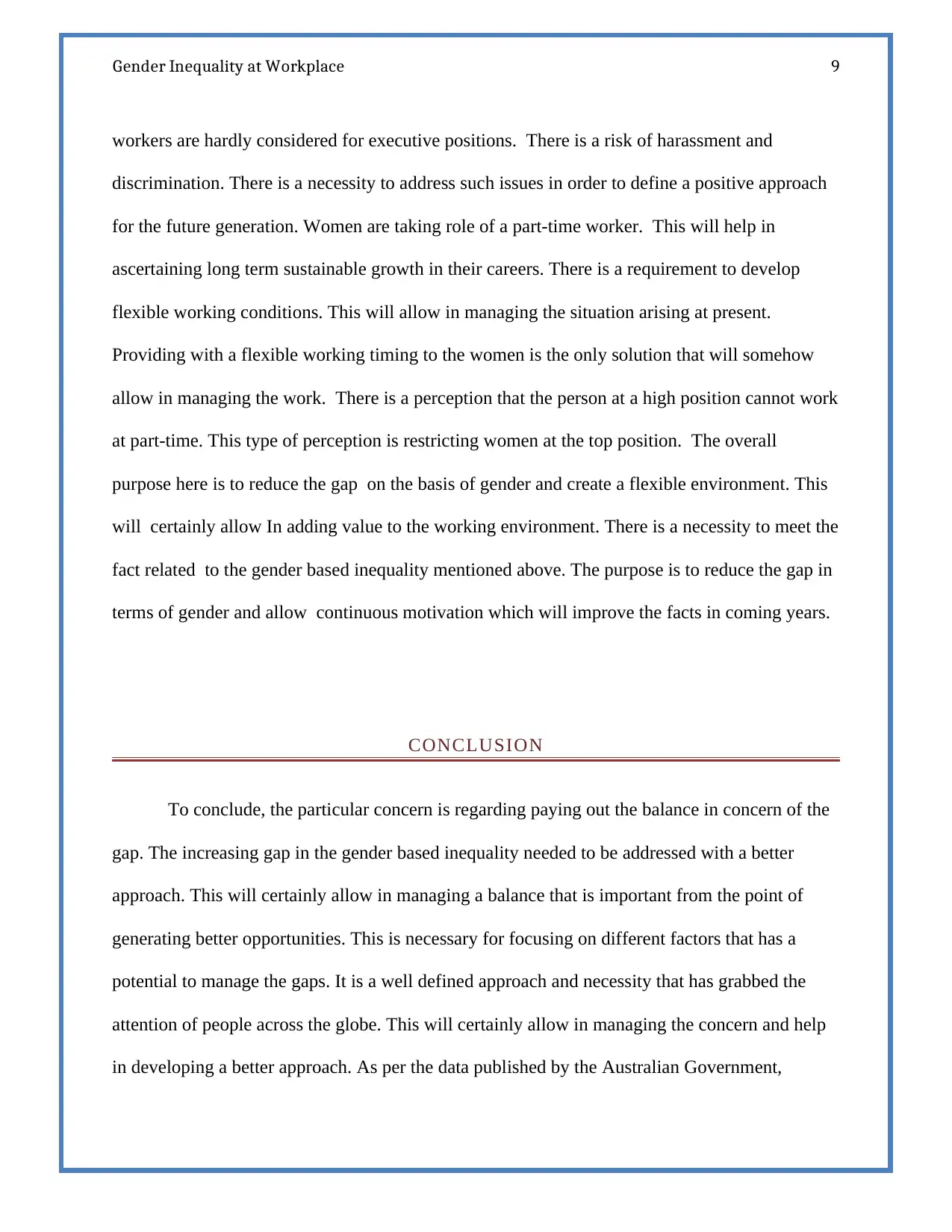
Gender Inequality at Workplace 9
workers are hardly considered for executive positions. There is a risk of harassment and
discrimination. There is a necessity to address such issues in order to define a positive approach
for the future generation. Women are taking role of a part-time worker. This will help in
ascertaining long term sustainable growth in their careers. There is a requirement to develop
flexible working conditions. This will allow in managing the situation arising at present.
Providing with a flexible working timing to the women is the only solution that will somehow
allow in managing the work. There is a perception that the person at a high position cannot work
at part-time. This type of perception is restricting women at the top position. The overall
purpose here is to reduce the gap on the basis of gender and create a flexible environment. This
will certainly allow In adding value to the working environment. There is a necessity to meet the
fact related to the gender based inequality mentioned above. The purpose is to reduce the gap in
terms of gender and allow continuous motivation which will improve the facts in coming years.
CONCLUSION
To conclude, the particular concern is regarding paying out the balance in concern of the
gap. The increasing gap in the gender based inequality needed to be addressed with a better
approach. This will certainly allow in managing a balance that is important from the point of
generating better opportunities. This is necessary for focusing on different factors that has a
potential to manage the gaps. It is a well defined approach and necessity that has grabbed the
attention of people across the globe. This will certainly allow in managing the concern and help
in developing a better approach. As per the data published by the Australian Government,
workers are hardly considered for executive positions. There is a risk of harassment and
discrimination. There is a necessity to address such issues in order to define a positive approach
for the future generation. Women are taking role of a part-time worker. This will help in
ascertaining long term sustainable growth in their careers. There is a requirement to develop
flexible working conditions. This will allow in managing the situation arising at present.
Providing with a flexible working timing to the women is the only solution that will somehow
allow in managing the work. There is a perception that the person at a high position cannot work
at part-time. This type of perception is restricting women at the top position. The overall
purpose here is to reduce the gap on the basis of gender and create a flexible environment. This
will certainly allow In adding value to the working environment. There is a necessity to meet the
fact related to the gender based inequality mentioned above. The purpose is to reduce the gap in
terms of gender and allow continuous motivation which will improve the facts in coming years.
CONCLUSION
To conclude, the particular concern is regarding paying out the balance in concern of the
gap. The increasing gap in the gender based inequality needed to be addressed with a better
approach. This will certainly allow in managing a balance that is important from the point of
generating better opportunities. This is necessary for focusing on different factors that has a
potential to manage the gaps. It is a well defined approach and necessity that has grabbed the
attention of people across the globe. This will certainly allow in managing the concern and help
in developing a better approach. As per the data published by the Australian Government,
⊘ This is a preview!⊘
Do you want full access?
Subscribe today to unlock all pages.

Trusted by 1+ million students worldwide
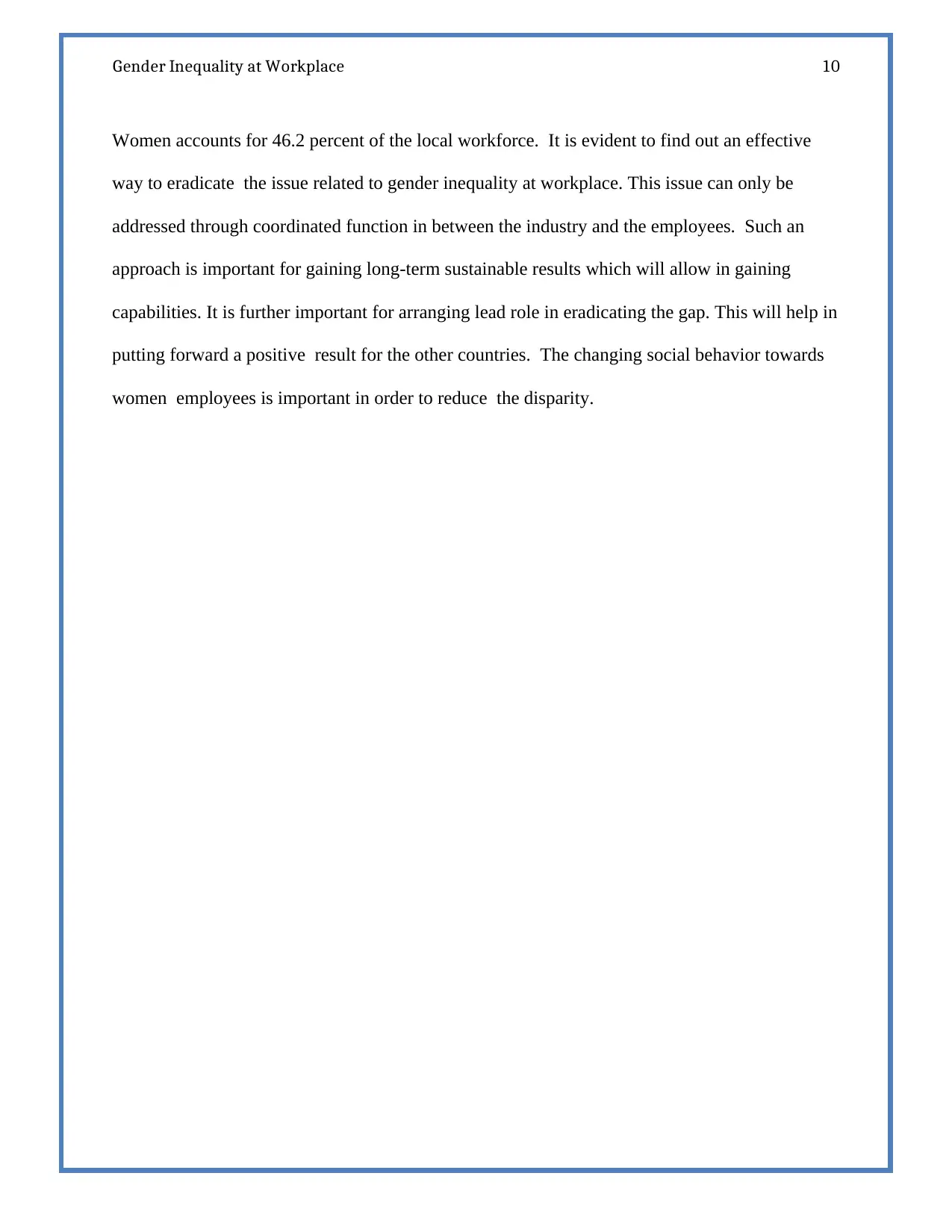
Gender Inequality at Workplace 10
Women accounts for 46.2 percent of the local workforce. It is evident to find out an effective
way to eradicate the issue related to gender inequality at workplace. This issue can only be
addressed through coordinated function in between the industry and the employees. Such an
approach is important for gaining long-term sustainable results which will allow in gaining
capabilities. It is further important for arranging lead role in eradicating the gap. This will help in
putting forward a positive result for the other countries. The changing social behavior towards
women employees is important in order to reduce the disparity.
Women accounts for 46.2 percent of the local workforce. It is evident to find out an effective
way to eradicate the issue related to gender inequality at workplace. This issue can only be
addressed through coordinated function in between the industry and the employees. Such an
approach is important for gaining long-term sustainable results which will allow in gaining
capabilities. It is further important for arranging lead role in eradicating the gap. This will help in
putting forward a positive result for the other countries. The changing social behavior towards
women employees is important in order to reduce the disparity.
Paraphrase This Document
Need a fresh take? Get an instant paraphrase of this document with our AI Paraphraser
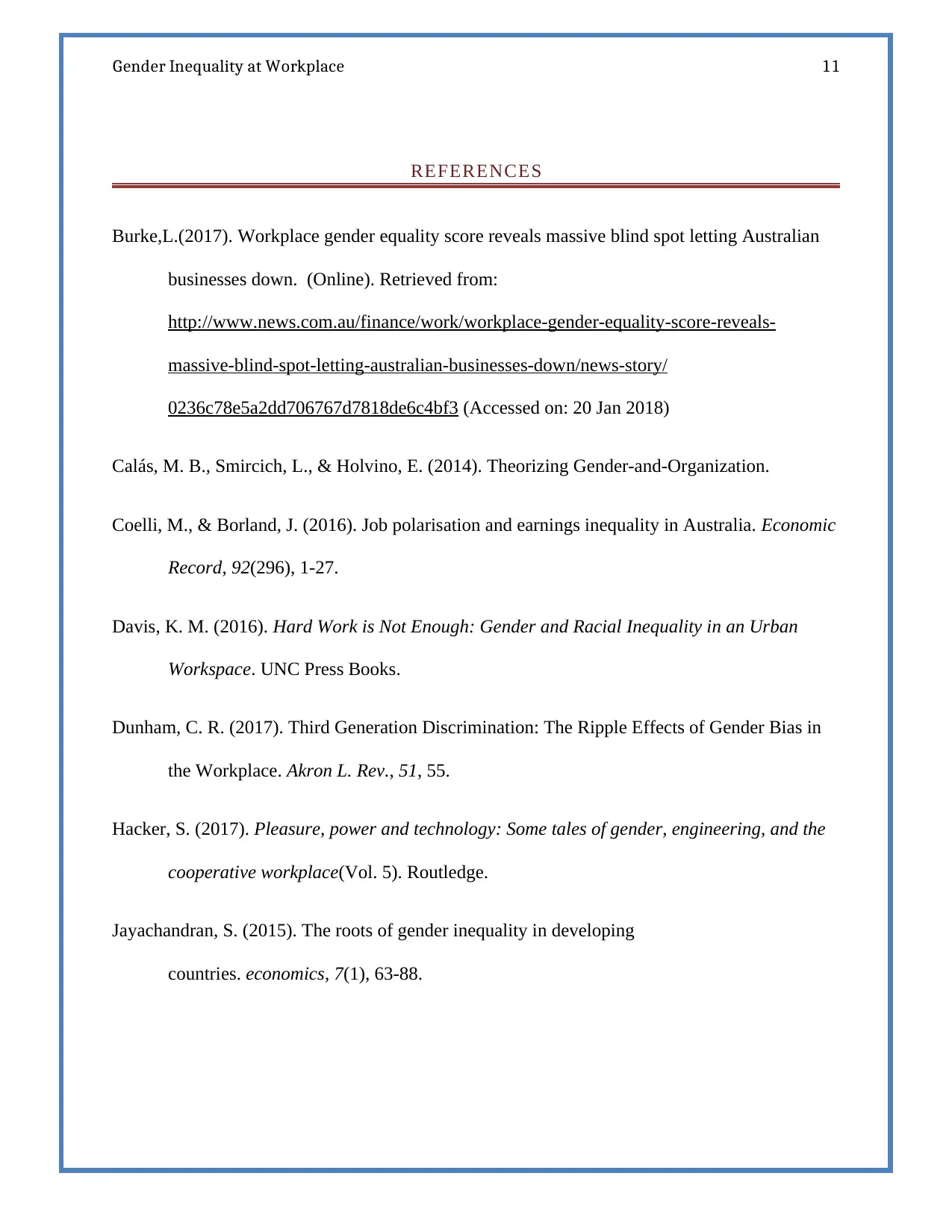
Gender Inequality at Workplace 11
REFERENCES
Burke,L.(2017). Workplace gender equality score reveals massive blind spot letting Australian
businesses down. (Online). Retrieved from:
http://www.news.com.au/finance/work/workplace-gender-equality-score-reveals-
massive-blind-spot-letting-australian-businesses-down/news-story/
0236c78e5a2dd706767d7818de6c4bf3 (Accessed on: 20 Jan 2018)
Calás, M. B., Smircich, L., & Holvino, E. (2014). Theorizing Gender-and-Organization.
Coelli, M., & Borland, J. (2016). Job polarisation and earnings inequality in Australia. Economic
Record, 92(296), 1-27.
Davis, K. M. (2016). Hard Work is Not Enough: Gender and Racial Inequality in an Urban
Workspace. UNC Press Books.
Dunham, C. R. (2017). Third Generation Discrimination: The Ripple Effects of Gender Bias in
the Workplace. Akron L. Rev., 51, 55.
Hacker, S. (2017). Pleasure, power and technology: Some tales of gender, engineering, and the
cooperative workplace(Vol. 5). Routledge.
Jayachandran, S. (2015). The roots of gender inequality in developing
countries. economics, 7(1), 63-88.
REFERENCES
Burke,L.(2017). Workplace gender equality score reveals massive blind spot letting Australian
businesses down. (Online). Retrieved from:
http://www.news.com.au/finance/work/workplace-gender-equality-score-reveals-
massive-blind-spot-letting-australian-businesses-down/news-story/
0236c78e5a2dd706767d7818de6c4bf3 (Accessed on: 20 Jan 2018)
Calás, M. B., Smircich, L., & Holvino, E. (2014). Theorizing Gender-and-Organization.
Coelli, M., & Borland, J. (2016). Job polarisation and earnings inequality in Australia. Economic
Record, 92(296), 1-27.
Davis, K. M. (2016). Hard Work is Not Enough: Gender and Racial Inequality in an Urban
Workspace. UNC Press Books.
Dunham, C. R. (2017). Third Generation Discrimination: The Ripple Effects of Gender Bias in
the Workplace. Akron L. Rev., 51, 55.
Hacker, S. (2017). Pleasure, power and technology: Some tales of gender, engineering, and the
cooperative workplace(Vol. 5). Routledge.
Jayachandran, S. (2015). The roots of gender inequality in developing
countries. economics, 7(1), 63-88.
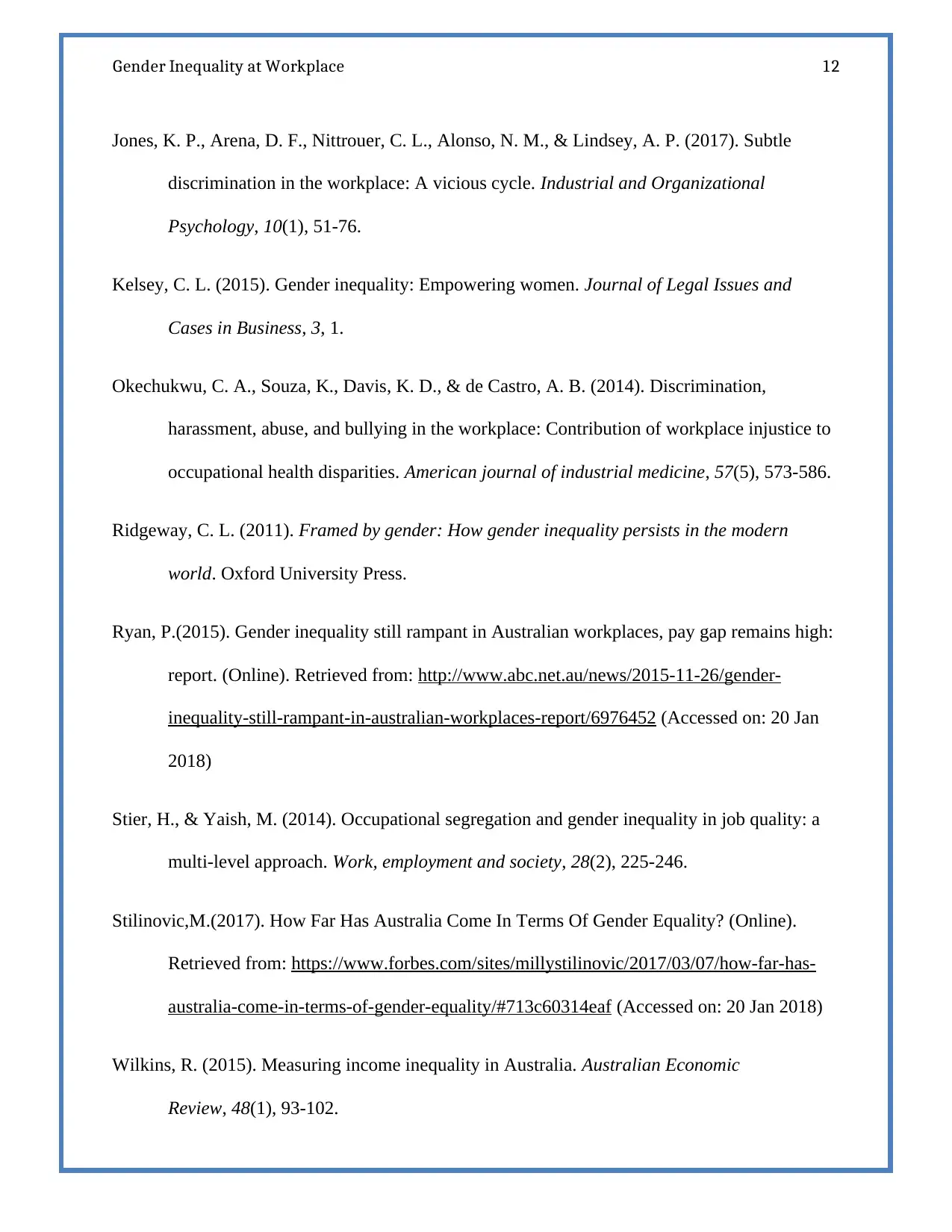
Gender Inequality at Workplace 12
Jones, K. P., Arena, D. F., Nittrouer, C. L., Alonso, N. M., & Lindsey, A. P. (2017). Subtle
discrimination in the workplace: A vicious cycle. Industrial and Organizational
Psychology, 10(1), 51-76.
Kelsey, C. L. (2015). Gender inequality: Empowering women. Journal of Legal Issues and
Cases in Business, 3, 1.
Okechukwu, C. A., Souza, K., Davis, K. D., & de Castro, A. B. (2014). Discrimination,
harassment, abuse, and bullying in the workplace: Contribution of workplace injustice to
occupational health disparities. American journal of industrial medicine, 57(5), 573-586.
Ridgeway, C. L. (2011). Framed by gender: How gender inequality persists in the modern
world. Oxford University Press.
Ryan, P.(2015). Gender inequality still rampant in Australian workplaces, pay gap remains high:
report. (Online). Retrieved from: http://www.abc.net.au/news/2015-11-26/gender-
inequality-still-rampant-in-australian-workplaces-report/6976452 (Accessed on: 20 Jan
2018)
Stier, H., & Yaish, M. (2014). Occupational segregation and gender inequality in job quality: a
multi-level approach. Work, employment and society, 28(2), 225-246.
Stilinovic,M.(2017). How Far Has Australia Come In Terms Of Gender Equality? (Online).
Retrieved from: https://www.forbes.com/sites/millystilinovic/2017/03/07/how-far-has-
australia-come-in-terms-of-gender-equality/#713c60314eaf (Accessed on: 20 Jan 2018)
Wilkins, R. (2015). Measuring income inequality in Australia. Australian Economic
Review, 48(1), 93-102.
Jones, K. P., Arena, D. F., Nittrouer, C. L., Alonso, N. M., & Lindsey, A. P. (2017). Subtle
discrimination in the workplace: A vicious cycle. Industrial and Organizational
Psychology, 10(1), 51-76.
Kelsey, C. L. (2015). Gender inequality: Empowering women. Journal of Legal Issues and
Cases in Business, 3, 1.
Okechukwu, C. A., Souza, K., Davis, K. D., & de Castro, A. B. (2014). Discrimination,
harassment, abuse, and bullying in the workplace: Contribution of workplace injustice to
occupational health disparities. American journal of industrial medicine, 57(5), 573-586.
Ridgeway, C. L. (2011). Framed by gender: How gender inequality persists in the modern
world. Oxford University Press.
Ryan, P.(2015). Gender inequality still rampant in Australian workplaces, pay gap remains high:
report. (Online). Retrieved from: http://www.abc.net.au/news/2015-11-26/gender-
inequality-still-rampant-in-australian-workplaces-report/6976452 (Accessed on: 20 Jan
2018)
Stier, H., & Yaish, M. (2014). Occupational segregation and gender inequality in job quality: a
multi-level approach. Work, employment and society, 28(2), 225-246.
Stilinovic,M.(2017). How Far Has Australia Come In Terms Of Gender Equality? (Online).
Retrieved from: https://www.forbes.com/sites/millystilinovic/2017/03/07/how-far-has-
australia-come-in-terms-of-gender-equality/#713c60314eaf (Accessed on: 20 Jan 2018)
Wilkins, R. (2015). Measuring income inequality in Australia. Australian Economic
Review, 48(1), 93-102.
⊘ This is a preview!⊘
Do you want full access?
Subscribe today to unlock all pages.

Trusted by 1+ million students worldwide
1 out of 13
Related Documents
Your All-in-One AI-Powered Toolkit for Academic Success.
+13062052269
info@desklib.com
Available 24*7 on WhatsApp / Email
![[object Object]](/_next/static/media/star-bottom.7253800d.svg)
Unlock your academic potential
Copyright © 2020–2025 A2Z Services. All Rights Reserved. Developed and managed by ZUCOL.





